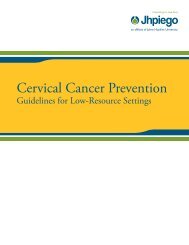Manual for Male Circumcision under Local Anaesthesia
Manual for Male Circumcision under Local Anaesthesia
Manual for Male Circumcision under Local Anaesthesia
You also want an ePaper? Increase the reach of your titles
YUMPU automatically turns print PDFs into web optimized ePapers that Google loves.
<strong>Male</strong> circumcision <strong>under</strong> local anaesthesia<br />
Version 3.1 (Dec09)<br />
Complications that occur within the first two weeks after surgery<br />
• Infection. After 2–3 days, the most likely problem is wound<br />
infection. An infection often causes increasing pain, and there may<br />
be visible signs, such as redness or purulent discharge. The<br />
patient should be given an appropriate antibiotic and advised to<br />
take frequent showers and to put a clean dressing on the wound<br />
between showers. If the infection is severe, the man should be<br />
advised to lie on his back, so that his penis is the highest point of<br />
his body. This promotes drainage of lymphatic fluid and speeds up<br />
the healing process. Sitting in a chair is a bad position.<br />
Alternatively the wound can be left without a dressing, but should<br />
be protected from flies.<br />
• Wound disruption and cutting out of stitches. When stitches<br />
cut out, this usually indicates that there is an infection, and the<br />
patient should be given antibiotics (see above). If more than 48<br />
hours have passed since the operation, do not try to re-suture the<br />
wound, as the new stitches are likely to become infected and also<br />
cut out, making the situation worse. The wound should be left to<br />
heal by secondary intention. The man should be seen at the clinic<br />
as often as necessary until the wound has healed. In general, the<br />
healing process after infection leaves an untidy result, at least <strong>for</strong><br />
the first few months. The man should be reassured that the<br />
appearance will usually become normal after about a year.<br />
• Worsening wound infection with signs of gangrene. A rare risk<br />
of genital surgery is infection with multiple bacteria, causing<br />
progressive skin loss. In this situation, the blood supply is cut off,<br />
and the skin becomes necrotic and turns completely black. This<br />
condition is known as Fournier’s gangrene (synergistic gangrene<br />
or necrotizing fasciitis) and is more common in men who have<br />
diabetes. Any man with signs of spreading infection or black<br />
gangrenous skin should be urgently transferred to a referral<br />
centre. At the referral centre, it is usually necessary to give a<br />
general anaesthetic and remove all the dead skin.<br />
Late complications<br />
In the long term, the client may complain of:<br />
• decreased sensitivity of the glans;<br />
• oversensitivity of the glans;<br />
• unsightly circumcision wounds, ragged scars or other cosmetic<br />
concerns;<br />
• persistent adhesions at the corona and inclusion cysts. These<br />
problems can be avoided if the <strong>for</strong>eskin is fully retracted during the<br />
operation and all adhesions carefully divided;<br />
• discom<strong>for</strong>t during erection from the scrotal being skin pulled up the<br />
shaft of the penis and a tight scrotal sac. This can result from<br />
removal of too much skin during the circumcision. These problems<br />
can be avoided by careful preoperative marking of the incision<br />
lines.<br />
Postoperative care and management of complications Chapter 7-8
















